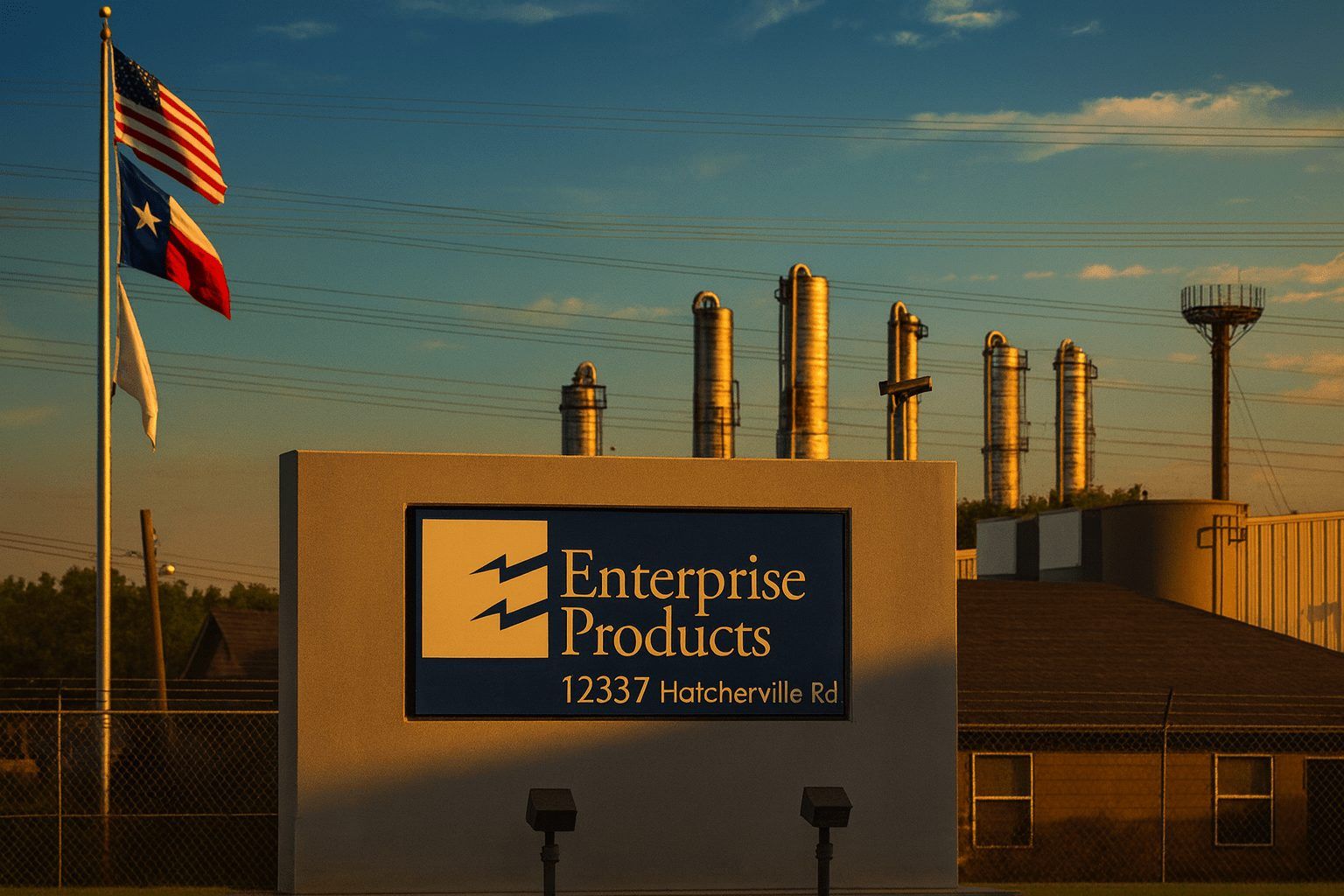Enterprise Products Partners L.P. (NYSE: EPD) heads into the new trading week as one of the most-watched income plays in the energy sector. Units are trading in the low‑$30s, offering a distribution yield of roughly 6.7% backed by a 27‑year streak of payout growth, a fresh joint venture with Exxon Mobil on the Bahia NGL pipeline, and a deep backlog of midstream projects. [1]
At the same time, softer 2025 earnings, new debt issuance and regulatory noise around exports are keeping expectations for unit price appreciation relatively modest, even as Wall Street still leans “Buy” on the name. [2]
EPD stock snapshot for November 24, 2025
As of the last close on Friday, November 21, 2025, Enterprise Products Partners units finished around $32.44 after a session that saw them trade between roughly $31.79 and $32.49. [3]
Key trading and valuation metrics:
- Last close: ~$32.44 per unit [4]
- 52‑week range: about $27.77 – $34.63, putting the current price in the middle of the band [5]
- Market cap: roughly $70 billion [6]
- Trailing P/E ratio: around 12x, below many large‑cap U.S. stocks [7]
- Beta: roughly 0.5–0.7, reflecting significantly lower volatility than the broader market [8]
For investors, that profile looks like a classic “steady, income‑heavy midstream” story rather than a high‑beta trade on commodity prices.
Dividend and distribution: Near‑7% yield with a long growth streak
The main reason many investors follow Enterprise Products Partners stock today is its distribution.
Current distribution and yield
- EPD currently pays a quarterly cash distribution of $0.545 per common unit, or about $2.18 annualized. [9]
- At a unit price near $32.44, that works out to a forward yield of roughly 6.7%. [10]
Management raised the distribution twice in 2025, moving from $0.535 early in the year to $0.545 in the second and third quarters. [11] That represents about 3.8% year‑over‑year growth for the third‑quarter payout. [12]
Several recent commentaries highlight that Enterprise has now increased its distribution for roughly 27 consecutive years, cementing its reputation as one of the more reliable income engines in midstream energy. [13]
Coverage and safety
Despite a softer earnings year, coverage remains solid:
- In Q3 2025, Enterprise generated about $1.8 billion in distributable cash flow (DCF), which covered common-unit distributions roughly 1.5 times. [14]
- Independent analysts estimate the distribution payout ratio (based on earnings) in the low‑80% range, which is high but consistent with an income‑oriented MLP and supported by stable fee‑based cash flows. [15]
Put simply: the payout is generous, but there is still a buffer for downturns and modest future hikes, assuming cash flows remain on track.
Q3 2025 earnings: Mixed headline, resilient cash flow
Enterprise’s latest results, reported at the end of October, were a classic “good and bad news” quarter. [16]
What went wrong:
- Revenue: Around $12.0 billion, down roughly 12–13% year over year, even though it came in slightly ahead of Wall Street estimates. [17]
- EPS: About $0.61 per unit, below consensus expectations near $0.68 and down from $0.65 in the prior‑year quarter. [18]
- Net income: Roughly $1.3 billion, a modest decline from the year‑earlier period. [19]
Those figures translated into a negative earnings surprise and helped explain some of the recent choppiness in the unit price. [20]
What held up well:
- DCF of about $1.8 billion still comfortably covered the distribution. [21]
- Return on equity remains robust, near 20%, reflecting efficient use of capital. [22]
- Management reaffirmed its long‑term capital project plans and continued buyback authorization, which allows repurchases of up to $5 billion in units (around 7% of float) when prices look attractive. [23]
The takeaway: 2025 has not been a breakout earnings year, but the core cash‑flow engine that funds EPD’s distribution looks intact.
Growth engine: Permian volumes, export capacity and the Exxon Bahia deal
Where the story gets more interesting for EPD stock today is in its project pipeline and new partnerships.
A deep backlog of midstream projects
Enterprise Products Partners is one of the largest midstream operators in North America, with more than 50,000 miles of pipelines and over 300 million barrels of liquids storage across NGLs, crude oil, refined products and petrochemicals. [24]
Management has sanctioned roughly $6–7.6 billion of growth projects scheduled for completion through 2025–2026, with a heavy focus on: [25]
- New and expanded gas processing plants in the Permian Basin
- Incremental NGL and natural gas pipelines
- Export terminal expansions along the Houston Ship Channel
NGL transportation volumes in the first half of 2025 were already running about 5% above the prior year, underscoring structural demand from petrochemicals and exports. [26]
Exxon takes 40% of Bahia NGL pipeline
The headline news for EPD this month is its new joint venture with Exxon Mobil:
- On November 20, 2025, Enterprise announced that Exxon Mobil will acquire a 40% stake in its Bahia natural gas liquids (NGL) pipeline. [27]
- Exxon will reimburse about $650 million for its share of project costs to date, giving EPD additional balance‑sheet flexibility. [28]
- The 550‑mile Bahia line, now in commissioning, is expected to start commercial service soon at roughly 600,000 barrels per day (bpd) of mixed NGLs moving from the Midland and Delaware basins to Enterprise’s Mont Belvieu hub in Texas. [29]
- Capacity is slated to expand to 1 million bpd by installing additional pumping stations and building a 92‑mile “Cowboy Connector” extension into New Mexico by late 2027. [30]
Enterprise will remain the operator of the combined system, while Exxon’s involvement helps de‑risk the project and anchors incremental volumes from its Permian processing facilities. [31]
For EPD unitholders, this deal matters because:
- It reduces Enterprise’s net capital outlay, freeing up cash for other projects, buybacks or balance‑sheet strength.
- It ties a blue‑chip producer directly into one of Enterprise’s strategic NGL corridors.
- It should support higher NGL throughput and fractionation volumes later this decade, supporting long‑term DCF growth. [32]
M&A and new processing capacity
Earlier this year, Enterprise also agreed to acquire Occidental Petroleum’s Midland Basin gas‑gathering affiliate for about $580 million, adding roughly 200 miles of gas pipelines and a long‑term dedication across 73,000 acres. [33]
As part of that transaction, Enterprise plans to build a new Athena gas processing plant in the Midland area, expected to handle up to 300 million cubic feet per day of gas and extract around 40,000 barrels per day of NGLs once it comes online, likely in 2026. [34]
These projects dovetail with management’s multi‑year capital plan, which envisions billions of dollars in capex in 2025 and 2026 aimed at reinforcing Enterprise’s status as a leading exporter of LPGs and other NGLs from the U.S. Gulf Coast. [35]
Balance sheet and recent debt issuance
One recurring question around high‑yield midstream stocks is leverage. Here, Enterprise sits in a relatively comfortable spot:
- Net debt metrics remain consistent with an investment‑grade profile, and the partnership has long maintained one of the stronger balance sheets in the MLP space. [36]
- Recent data show a debt‑to‑equity ratio just over 1x, and an interest coverage ratio above 4x. [37]
In November, Enterprise priced about $1.65 billion of new senior notes with coupons in the 4.3–5.2% range, largely to refinance existing obligations and fund capital projects. [38] Locking in long‑term fixed‑rate debt at those levels helps limit interest‑rate risk while still leaving plenty of room under its leverage targets.
Key risks: Exports, regulation and energy transition
Even for a “steady Eddie” midstream name like EPD, investors should keep a few risk factors in mind.
Export and regulatory risk
In June, Enterprise disclosed that the U.S. Commerce Department planned to deny licenses for three ethane cargoes to China, citing national‑security concerns. The news briefly pressured EPD shares and underscored the sensitivity of hydrocarbon exports to geopolitics. [39]
While this is a relatively small piece of Enterprise’s overall business, it highlights that:
- Export‑oriented growth can face sudden regulatory headwinds.
- Political shifts can influence which markets U.S. NGLs are allowed to reach, potentially affecting realized margins.
Commodity cycles and demand
Enterprise’s contracts are largely fee‑based, but not entirely immune to volumes and commodity spreads. Slower drilling in the Permian or weaker petrochemical demand could soften throughput growth in coming years, even if current forecasts call for Permian NGL production to rise more than 30% between 2024 and 2030. [40]
Longer term, the global energy transition toward lower‑carbon fuels and chemicals could change the growth profile of NGLs and petrochemicals, although most analysts still see a multi‑decade role for these products.
Analyst views, price targets and EPD stock forecast
Despite near‑term earnings noise, Wall Street remains broadly constructive on Enterprise Products Partners.
- Across multiple surveys, most covering analysts rate EPD a “Buy,” with a minority at “Hold” and virtually none recommending “Sell.” [41]
- The average 12‑month price target generally sits around $35–36 per unit, implying roughly 8–12% upside from current levels near $32, with high estimates in the upper‑$30s to $40 range and lows in the low‑$30s. [42]
- UBS recently reiterated a “Buy” rating with a $38 price target, explicitly tying part of its optimism to the Bahia pipeline joint venture with Exxon. [43]
Some research notes also argue that, because EPD already trades close to long‑term fair‑value estimates (many in the mid‑$30s), upside may be “modest but steady” rather than explosive, with total returns driven mostly by distributions plus low‑single‑digit unit price appreciation. [44]
Meanwhile, income‑focused analysts frequently call Enterprise one of the strongest and best‑run midstream operators, pointing to its near‑7% yield, conservative culture and long payout streak as key differentiators. [45]
Tax considerations: EPD is an MLP, not a regular corporation
An important detail for prospective investors: Enterprise Products Partners is structured as a master limited partnership (MLP), not a traditional C‑corp.
That means:
- Investors typically receive a K‑1 form at tax time rather than a standard 1099.
- A large portion of the distribution is often classified as return of capital, which can defer taxes but lowers your cost basis. [46]
- Holding MLP units in certain tax‑advantaged accounts (like IRAs) can introduce complexities around unrelated business taxable income (UBTI), so investors often consult a tax professional before loading up in retirement accounts.
For many taxable investors, those features can be attractive, but they do add paperwork and complexity compared with a normal dividend‑paying stock.
Is Enterprise Products Partners (EPD) stock a buy right now?
Whether EPD is a good buy today, November 24, 2025, depends on what you’re looking for:
EPD may appeal to you if:
- You prioritize reliable, high current income and are comfortable with MLP tax paperwork.
- You like the idea of a large, diversified midstream franchise with investment‑grade credit and visible long‑term projects tied to Permian growth and export demand. [47]
- You’re content with a likely high single‑digit total return profile built from a ~6.7% yield plus low‑single‑digit distribution growth and moderate price appreciation.
EPD may not be ideal if:
- You want fast capital gains or high‑beta exposure to oil and gas prices.
- You prefer simpler tax reporting and don’t want to deal with K‑1s or MLP‑specific rules.
- You’re worried about long‑term regulatory or decarbonization risk for fossil‑fuel infrastructure.
Right now, the market seems to be pricing Enterprise as a relatively steady, mature income vehicle with limited but positive upside, while the underlying business continues to expand its footprint through projects like Bahia and the Athena plant. [48]
For investors who know they want a high‑yield midstream core holding, the combination of scale, balance‑sheet strength, project backlog and payout history keeps EPD firmly in the conversation.
This article is for informational purposes only and does not constitute investment, tax or legal advice. Always do your own research or consult a licensed professional before making investment decisions.
References
1. markets.financialcontent.com, 2. www.nasdaq.com, 3. www.marketwatch.com, 4. finance.yahoo.com, 5. finance.yahoo.com, 6. www.marketbeat.com, 7. www.marketbeat.com, 8. public.com, 9. markets.financialcontent.com, 10. public.com, 11. www.dividend.com, 12. markets.financialcontent.com, 13. seekingalpha.com, 14. finance.yahoo.com, 15. www.marketbeat.com, 16. ir.enterpriseproducts.com, 17. www.nasdaq.com, 18. www.nasdaq.com, 19. site.financialmodelingprep.com, 20. finance.yahoo.com, 21. finance.yahoo.com, 22. www.marketbeat.com, 23. www.marketbeat.com, 24. ir.enterpriseproducts.com, 25. finance.yahoo.com, 26. ir.enterpriseproducts.com, 27. www.reuters.com, 28. www.reuters.com, 29. www.reuters.com, 30. www.reuters.com, 31. www.reuters.com, 32. finance.yahoo.com, 33. www.mrt.com, 34. www.mrt.com, 35. finance.yahoo.com, 36. www.investors.com, 37. public.com, 38. www.stocktitan.net, 39. www.reuters.com, 40. corporate.exxonmobil.com, 41. stockanalysis.com, 42. stockanalysis.com, 43. www.investing.com, 44. www.tikr.com, 45. www.fool.com, 46. www.nasdaq.com, 47. seekingalpha.com, 48. www.reuters.com










